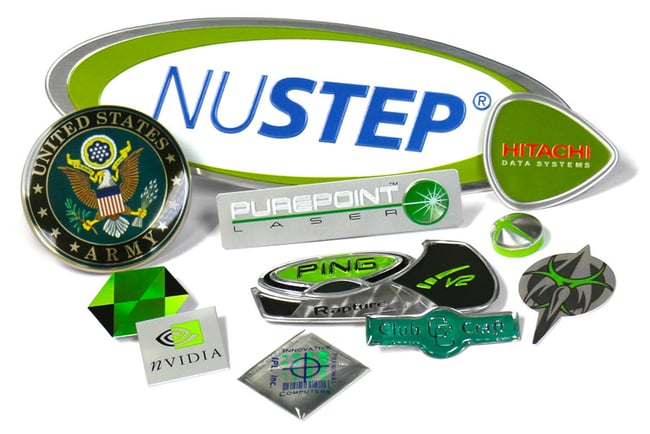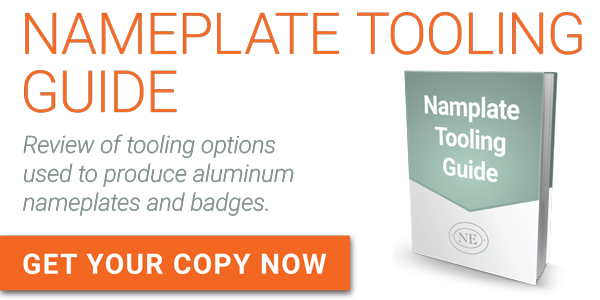Basic Tool Information for Aluminum Nameplates
Aluminum nameplates are produced with hard tools and can be as simple as a blank die to cut a flat part or as complex as multi-level emboss and form operations for a dimensional badge. Understanding the basics of these operations will help you in the design of your part.
Blank Dies
Any tool for stamping aluminum will have at minimum a blank operation. This operation involves male and female hardened steel coming together in a punch press. It cuts the aluminum to the shape of the design. Individual parts then proceed through inspection and packing before product is shipped.
A pierce or hole sometims can be punched at the same time that the blank is cut. The final design may require a separate tool operation for a hole, depending on what happens next in the operation steps.
Standard tolerances need to be taken into consideration for the size of the part. Acceptable range of ±.005" should be allowed for size including hole location when necessary. ±.015" tolerance should be used for registration of graphics to the blank. Tolerances are subject to review on a case by case scenario.

Emboss Dies
In order to have raised areas, text or graphics on your aluminum nameplate or trim piece a custom tool is required. This allows your design to show dimension, add detail to a specific area or draw attention to a logo.
Artwork files for embossed nameplates and trim need to take into consideration stroke and space width of .015" as well as .005" space to edge of the part. The stroke is important for registration of the emboss as well as allowing for the stretching of the aluminum as it is put through the die. Spacing is important so that the emboss does not get cut out when the part is blanked.
The emboss operation is typically separate from the blank and requires precise registration for decoration. Emboss can be one level - meaning that each embossed feature is raised to the same height. If more detail is needed, other emboss options include multi-level, beveled and dimensional. The registration is perfected during the tool build with die trials performed before decoration of stock is scheduled. This ensures a repeatable, quality process for production orders.
Standard tolerances need to be taken into consideration for the emboss and its registration for any printing or decoration and the blank operation. Tolerance of ±.015" should be allowed between each embossed feature. Emboss height and registration to the blank should allow ±.005". Tolerances are subject to review on a case by case scenario.

Form Dies to Add Height
Sometimes it is desirable to have the aluminum nameplate or badge stand up from the surface of the product it is attaching to. Perhaps the design is to replicate or replace a die cast part. Aluminum can have a wiped or formed over edge. This provides the illusion of a much thicker part, keeping weight and material cost down. It also finishes the edge and hides the raw aluminum edge from showing.
Form dies need to take into consideration the skirt length and bend radius. Dimensional print/CAD files are generally needed to fully understand and determine the tooling required. Each project is unique and will need to have review of the dimensions to determine manufacturing feasibility.
A form die requires further discussion and understanding for the attachment to the end product. Depending on which attachment is used, additional adhesive or assembly operations may be required as part of the tooling process.

Maximize Tooling
Once a tool is identified, take advantage of the shape and use it across your product lines. The investment made to create a tool can be carried across multiple model years and used for facelift designs. Many customers use this as the avenue to have a recognizable shape for their logo, or to carry the brand across similar types of products, targeted to different demographics.

Armed with this basic information for the tooling options used to create aluminum nameplates and badges you can begin to put together your design. Keep in mind the more operations that you include increase the complexity as well as the initial investment and time needed to build the tool.
Related Articles
Metal Stamping FAQ
Plastic Tooling FAQ
Prototype Tooling FAQ
Ready for more conversation on your aluminum nameplate tooling options? Let's talk!
Subscribe to Nameplate Blog
- 2021 (1)
- 3D (4)
- Adhesives (11)
- Aluminum (129)
- Aluminum In-mold (9)
- Aluminum Trim (41)
- Anodize (4)
- Appliance (12)
- Appliqué (5)
- Archive (35)
- Artwork Submission (4)
- Assembly (6)
- Automotive (35)
- Backlit (5)
- Boats (6)
- Brass (8)
- Brushed Aluminum (19)
- Carbon Fiber (2)
- Classic (1)
- Coined (5)
- Color Development (25)
- Computers (13)
- Cosmetics (24)
- Custom Patterns (11)
- Customization (16)
- Customized Patterns on Aluminum (2)
- Debossing (13)
- Diamond Cut (22)
- Digital Printing (2)
- ebook (4)
- Electronics (23)
- Embossing (53)
- Etched (20)
- Exterior (9)
- FAQ (29)
- Faux Finish (1)
- Faux Finishes (7)
- Favorite Nameplate (20)
- Furniture (9)
- Gauges (5)
- Gloss (4)
- Hang Tag (1)
- IDSA (1)
- In-mold Decoration (5)
- Individual Letters (7)
- Inlay (1)
- Key Fob (1)
- Labels (10)
- Large Vehicle (4)
- Laser Etch (2)
- Lithography (3)
- Match Box Cover (6)
- Materials and Processes (118)
- Mechanical Finishes (51)
- Medical Equipment (10)
- Metallic (8)
- Motorcycle (11)
- Nameplate (175)
- Nameplate Examples (54)
- Nameplate Tools (7)
- Outdoor Equipment (4)
- Overlay (7)
- Packaging (15)
- Patina Finish (3)
- Plastic (1)
- Plastic Trim (3)
- Point of Purchase (8)
- Polycarbonate (10)
- Process Color (16)
- Promotional Products (38)
- Prototypes (2)
- Recreational Vehicles (6)
- Resources (11)
- Safety Labels (2)
- Selective Patterns (10)
- Sill Plate (6)
- Sports Equipment (9)
- Stainless Steel (17)
- stock dies (10)
- Surfaces (4)
- Sustainability (1)
- Technical (1)
- Telecommunications (9)
- Testing (3)
- Texture (15)
- Top 10 (9)
- Woodgrain (2)






